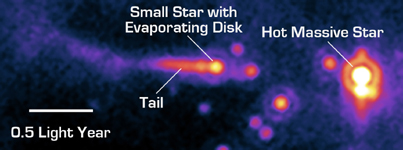
|
A Star’s Close Encounter
- Click the image above for a larger view
- Full-Res JPEG (1500 x 558) (43.5 kB)
- Full-Res TIFF (1500 x 558) (839.7 kB)
Caption:
The potential planet-forming disk (or "protoplanetary disk") of a sun-like star is being violently ripped away by the powerful winds of a nearby hot O-type star in this image from NASA's Spitzer Space Telescope. At up to 100 times the mass of sun-like stars, O stars are the most massive and energetic stars in the universe.
The O star can be seen to the right of the image, as the large orange spot with the white center. To the left, the comet-like structure is actually a neighboring solar system that is being destroyed by the O star's powerful winds and intense ultraviolet light.
In a process called "photoevaporation," immense output from the O star heats up the nearby protoplanetary disk so much that gas and dust boil off, and the disk can no longer hold together. Photon (or light) blasts from the O star then strip the potential planet-forming disk off its neighbor star by blowing away evaporated material. This effect is illustrated in the smaller system's comet-like structure.
The system is located about 2,450 light-years away in the star-forming cloud IC 1396. The image was taken with Spitzer's multiband imaging photometer instrument at 24 microns. The picture is a pseudo-color stretch representing intensity. Yellow and white represent hot areas, whereas purple and blue represent relatively cooler, fainter regions.
Cataloging Keywords:
| Name | Value | Additional Values |
|---|---|---|
| Target | IC 1396 | |
| System | IC 1396 | |
| Target Type | Exoplanet | |
| Mission | Spitzer Space Telescope | |
| Instrument Host | Spitzer Space Telescope | |
| Host Type | Space Telescope | |
| Instrument | Multiband Imaging Photometer for Spitzer (MIPS) | |
| Detector | ||
| Extra Keywords | Color, Disk, Dust, Infrared, Ultraviolet | |
| Acquisition Date | ||
| Release Date | 2006-10-03 | |
| Date in Caption | ||
| Image Credit | NASA/JPL-Caltech/Univ. of Ariz./Univ. of Szeged | |
| Source | photojournal.jpl.nasa.gov/catalog/PIA01319 | |
| Identifier | PIA01319 | |

